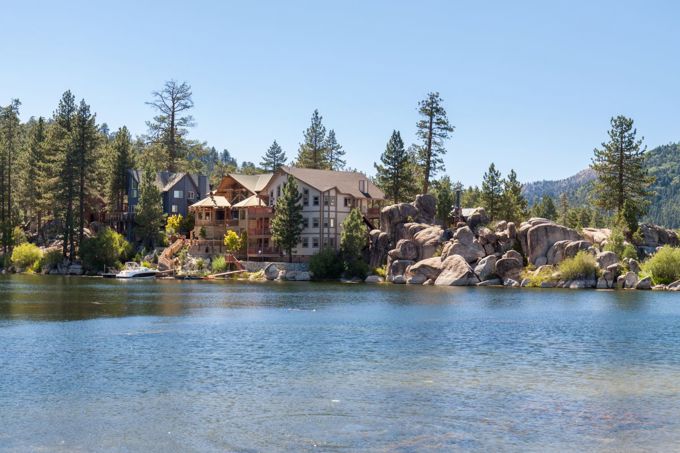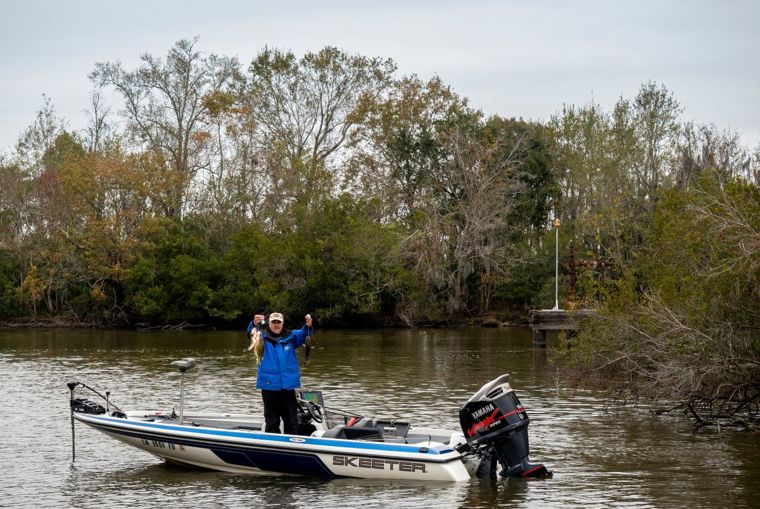
Do I Control What Happens on the Water at My Waterfront Property on a Creek, River, Bay or Shore of the Sea?
Can You Control the Water on Your Waterfront Property?
In our previous bottomland ownership post, we tackled the question of whether the owner of waterfront property can stop noisy jet skiers, or boaters, who park just offshore to fish, socialize or party? The answer, we wrote then, is that “it depends” and (we pointed out) figuring out who owns the bottomland (i.e. the land underneath the water) is the key to finding the answer to the question.
We also explained in the bottomland ownership post that we have to divide Virginia waters into two very broad categories before we can explain how much power the waterfront property owner to control activities on the water next to his or her land.
The first category is lakes and ponds. We covered that category of waterfront property in our lakes and ponds bottomland ownership post. There, we said that the waterfront property owner at a lake or a pond may have a large amount of control over what happens out on the water. The second category is made up of waterfront property owners on bays, rivers, creeks and the shores of the sea in Virginia. This blog post will tell you how it works for them.
Understanding the Role Bottomland Ownership Plays
We begin with an obvious, all-important fact. Waterfront property owners paid (a lot!) extra to get that beautiful view and the water-related recreational amenities. We are sympathetic when we hear from waterfront property owners who contact us saying that some objectionable activity, whether it be floating aquaculture or a gang of noisy jet skiers, is spoiling their surroundings and wrecking their property value.
Once we sort out how bottomland ownership works on the bays, rivers, creeks and seashores in Virginia then we can answer these important questions:
If I own waterfront property on a bay, river, creek or seashore in Virginia...
- Can I prevent people from fishing in the water next to my property?
- Can I prevent noisy jet skiers from racing through the water next to my property?
- Can I prevent boaters from anchoring and having a party in the water next to my property?
- Do my property lines extend into the water?
- Where does my property line end?
- How do the property lines limit where I can build a dock or a pier?
If there is more than one waterfront property owner on the bay, river, creek or seashore in Virginia where I own waterfront property, do we share rights to the water?
Who handles property line disputes at my waterfront property on a bay, river, creek or seashore in Virginia?
How are riparian property lines determined at my waterfront property on a bay, river, creek or seashore in Virginia?
Is it possible to own...
- A river? Can a river be private property?
- A creek? Can a creek be private property?

(Petrenko Andriy / shutterstock.com)
The Commonwealth Normally Owns The Bottomland Of The Bays, Rivers, Creeks And Seashores In Virginia
For bottomland of the bays, rivers, creeks and seashores of Virginia, Virginia code section 28.2-1200 places ownership of nearly all of that bottomland in the Commonwealth of Virginia. This code section says that “All the beds of the bays, rivers, creeks and the shores of the sea [are] the property of the Commonwealth and may be used as a common by all the people of the Commonwealth for the purpose of fishing, fowling, hunting, and taking and catching oysters and other shellfish.”
This would seem to settle the question of who owns the bottomland in the bays, rivers, creeks and seashore but there are two important exceptions. Each exception creates opportunities for these bottomlands to be privately owned.
Bottomland On Non-navigable Rivers And Creeks Is Privately Owned
If waterfront property is located on a river or creek that is not navigable then the bottomland will be privately owned. This means that the property lines for the waterfront property owner will extend out into the water, typically to the center of the waterbody. This also means that these waterfront property owners will have a large ability to control what happens on the water within the boundaries of their property.
Waterfront property owners on a bay or the seashore will never qualify for this non-navigability exception because these waterbodies are subject to the ebb and flow of the tide. Hence, by law, they are deemed navigable. Those rivers and creeks that are tidal are likewise considered navigable.
Virginia River and Creek Laws Determine Bottomland Ownership
But there are, however, some rivers and creeks that are not tidal. As to the non-tidal rivers and creeks, a landmark Virginia Supreme Court case defines “navigable” as meaning that the waterbody is used, or is susceptible of being used, in its natural condition, as a “highway of commerce on which trade or travel are or may be conducted”. Boerner v. McAllister, 197 Va. 169 (1955).
Any waterfront property owner on a non-tidal river or creek is eligible to own the bottomland at that waterbody so long as the particular river or creek is not used (and is not susceptible to being used) as a “highway of commerce on which trade or travel are or may be conducted”.
The Advantage of Living on A Non-Navigable River or Creek
In the case of these non-navigable rivers and creeks, the waterfront property owner owns the bottom out to the centerline of the watercourse. Although we have found no Virginia case that so holds, when it comes to controlling what happens on the waterbody of this type, it would appear that these waterfront owners would have rights comparable to the rights enjoyed by waterfront owners on a lake or pond.
As explained in our lake and pond bottomland post this class of waterfront property owners typically hold a large ability to control what takes place on the water next to their property. They can certainly prevent someone from building a pier or dropping anchor on their property and they may even be able to halt an entire range of activities such as fishing, swimming, and boat travel.

(Victor Wong / Shutterstock.com)
Bottomland Granted By The Sovereign Is Privately Owned
There are places in Virginia where the bottomland was conveyed into private ownership by the British Crown in the time prior to the American Revolution (under a so-called “King’s Grant”). There are as well places where the bottomland was conveyed into private ownership by Virginia at some point after the American Revolution.
These bottomlands are privately owned as specified by deed. In most instances the waterbody would be considered navigable and the waterfront owner cannot prevent boat travel in the water flowing over his or her bottomland. They could however, prevent someone from building a pier or dropping anchor on their property. Depending on the wording in the King’s Grant, the waterfront owner may even be able to stop others from fishing in the waters above his or her bottomland.
Most Of The Bottomland On The Bays, Rivers, Creeks And Seashores In Virginia Are Owned By The Commonwealth Of Virginia And Are Not Owned By The Waterfront Property Owners
The non-navigable rivers and creeks, and the bottomland conveyed by the various King’s Grants, put a small area of Virginia bottomland into private ownership. The vast majority of waterfront property owners on a bay, river, creek or seashore in Virginia own no bottomland.
Virginia Code section 28.2-1202(A) tells these waterfront property owners that the “mean low-water mark” is the property line that divides their land from the bottomland owned by the Commonwealth. For this class of waterfront property owners, the Commonwealth holds the majority power to control the activities taking place on the water.
When you think about this remember that Virginia Code section 28.2-1200 said not only that the Commonwealth owned these bottomlands but went on to say that these bottomlands are a “common” to be used by all of the people for fishing, hunting, fowling and catching oysters. This code section means that the waterfront property owner should understand that the water alongside his or her property is open to the public.
Alternative Legal Power when Bottomland Ownership in Unavailable
There is however a minority residual legal power that remains in the hands of the waterfront property owner. This legal power is known under Virginia law as the riparian property rights. As we have explained in great detail elsewhere in this blog, these riparian property rights are a set of five distinct rights. Also, as we have explained previously in this blog, these riparian property rights apply only within a zone in the waterbody called the “riparian area”.
If you own waterfront property on a bay, navigable river, navigable creek or on the seashore in Virginia then, unless you hold a King’s Grant, you cannot prevent people from fishing the waters next to your property, you cannot prevent jet skiers or boaters from traveling through those waters, you cannot stop boaters from anchoring in those waters, and your property line does not extend into the water.
Exercising Your Riparian Property Rights in Your Riparian Area
You can, however, exercise your riparian property rights to build a pier in your riparian area, you have a right of way that entitles you to navigate a vessel from the shore at your property out to the navigable part of the waterbody, and you have a right to make reasonable use of the water flowing past your property (i.e. for irrigation or domestic household uses, to name a few).
What is a bottomland and who owns it?
Bottomland refers to the land under the water adjacent to a waterfront property. In the Commonwealth of Virginia, the state normally owns the bottomland of bays, rivers, creeks, and seashores. The common law “Public Trust Doctrine” and Virginia code section 28.2-1200 require Virginia to operate its state-owned bottomland for the benefit of all Virginians. Some bottomland is privately owned. On non-navigable rivers and creeks, the bottomland is owned by the waterfront property owners. The bottomland beneath all of the ponds and lakes in Virginia is privately owned. Additionally, English royalty conveyed some bottomland into private ownership in the era prior to the American Revolution through issuance of a so-called “King’s Grant”. These “King’s Grant” bottomlands have been bought and sold through the years and remain in private ownership to the present day. The owners of any of these types of privately-owned bottomlands are not required to follow the requirements of the “Public Trust Doctrine” nor the requirements of Virginia code section 28.2-1200.
Important Virginia River Laws
Of the great many important Virginia River Laws, one that is of great importance is the legal process for determining whether a river is navigable. The law, at 33 C.F.R. part 329, places responsibility on the U.S. Army Corps of Engineers to make determinations concerning navigability. The tidal reaches of a river are always considered navigable. In the non-tidal reaches, the determination of navigability rests on whether the particular section of the river is presently used, or has been used in the past, or may be susceptible for use to transport interstate or foreign commerce. Other important Virginia river laws are the federal Rivers and Harbors Act of 1899 regulating the placement of obstructions to navigation in our rivers, the admiralty and maritime laws governing navigation on rivers, the federal and state environmental laws governing discharge of pollution into rivers, the state laws overseeing withdrawal of surface waters from Virginia’s rivers, the state laws regulating fishing (whether by hook and line, rod and reel or net) in the rivers of Virginia, and the state laws governing the taking of shellfish from Virginia rivers.
Are creeks private property Virginia?
The bottomland beneath a creek will normally be privately owned because most creeks are not navigable. The water flowing in a creek, however, is not private property. Similarly, the fish, amphibian and other wildlife in the creek are not private property. The plants growing in the creek are owned by the waterfront property owner but state law, such as the Chesapeake Bay Preservation Act, may restrict the ability of the property owner to remove or otherwise disturb the plants.
In Conclusion
As you can see from reading this article, purchasing waterfront property on a bay, river, creek of shore of the sea in Virginia is expensive and it brings up a very complicated area of the law requiring special expertise.
If you have any further questions about bottomland property rights at any waterfront property in Virginia, our experienced team is happy to help. Feel free to contact us here.
